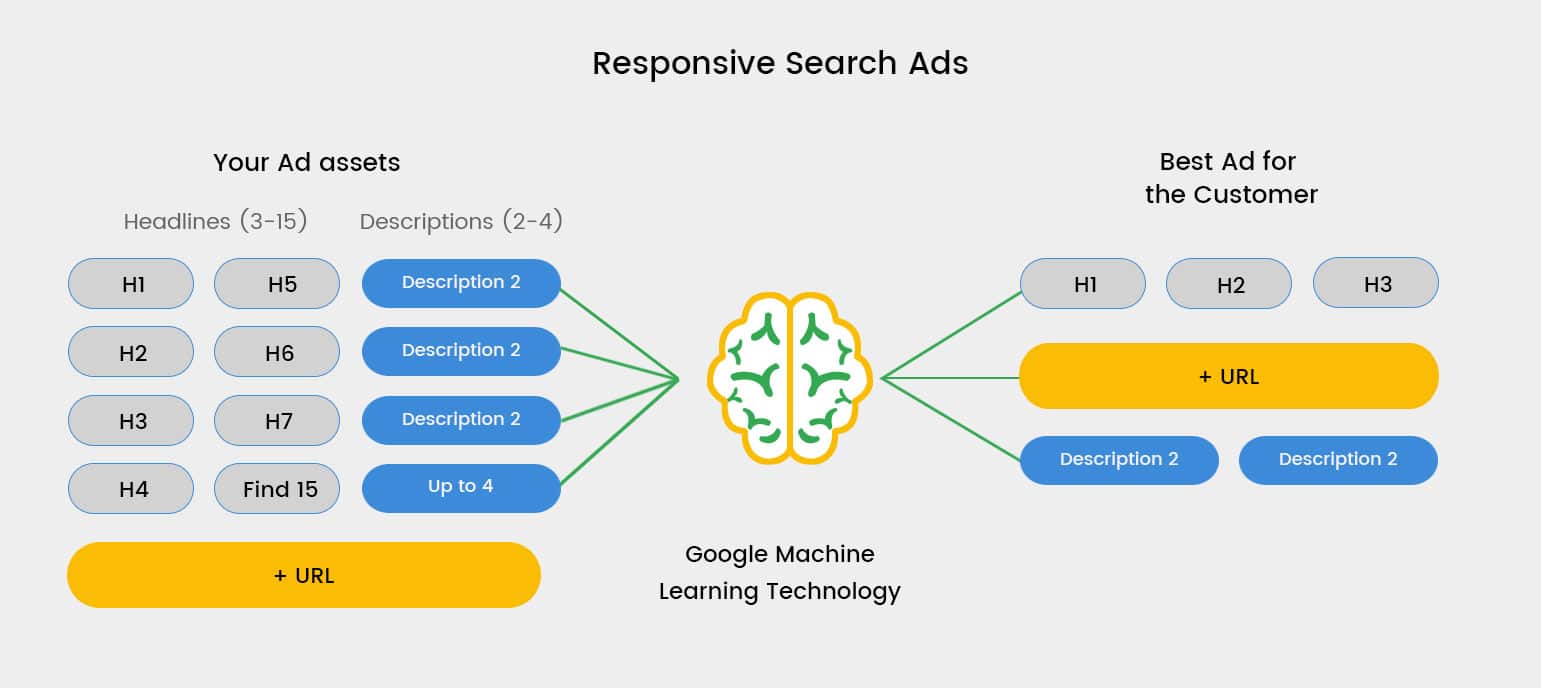Best Responsive Search Ads Practices for PPC
Responsive Search Ads can be one of the best features of Google Ads. The significance of this type of ad comes from personalization; there is no single defined ad. Still, instead, there are several versions of the advertisement to fit different circumstances.
Indeed, the advertisement might be appearing for the same website, product, or service. However, you should always keep in mind that people can and will have different search intents, and it would be best if you had different options to best represent what you have for different search intents.
You might have heard that responsive search ads recently became the default type of ads for Google, which only increases the significance of those kinds of ads. And it gets better. Once you understand how you can blend responsive search ad practices with pay-per-click ads, you can be your master of Google Ads, with wonderful results.
Today in this article, we will talk about what are responsive search ads, their characteristics, brief information about pay-per-click ads, and how to implement responsive search ads to pay-per-click search campaigns. Without further ado, let’s get started.

What are Responsive Search Ads?
Responsive search ads are types of Google ads in which advertisers have control over defining more than one headline and description for their ads. In other words, with responsive search ads, an advertiser can write multiple headlines and descriptions for their advertisements, which will be represented according to the search intent of the user.
Responsive search ads were announced to make ads more relevant and informative to the user. Indeed, an ad might include the need for multiple users, but those users might not have the same intent. For example, two different users might need to get to the same ad, one for signing up for the newsletter and the other one for purchasing a good: two motivations, two different ads, same webpage.
Moreover, responsive search ads are known to be the perfect optimizer for pay-per-click ads, which happens to be another main topic of this article. For pay-per-click ads, Google uses artificial intelligence to see which combination of the headlines and descriptions the advertiser wrote works best for different search intents and optimize your advertisement in the best way possible.
Indeed, delivering the proper message to the right audience in the right place is one of the most essential things in any given advertisement, and responsive search ads exactly provide this to its users. Google announced that responsive search ads could increase the conversion rates of a given campaign up to ten percent.
Of course, there are other benefits of responsive search ads in a given campaign. The following are some of the most important benefits an advertiser can get out of the best use of this type of ad.
More and Right Audience
Perhaps the most important feature of responsive search ads is to reach a larger audience. Additionally, this large audience is better in terms of fitting to the target of the ad campaign. Multiple headings and descriptions mean more space for optimized keyword use, which is a crucial point when it comes to finding the right audience.
Better Mobile Experience
A good proportion of search engine queries are performed in the mobile environment. And anyone who is interested in Google Ads or SEO, in general, must know how crucial it is to offer a mobile-friendly experience to your visitors for obvious reasons.
Since responsive search ads are characterized by being adaptive and responsive, they are perfect for mobile optimization. If the web version of an advertisement is not appropriate or optimal for the mobile experience, responsive search ads will adapt it to be correctly shown.
Analyzing Made Easy
A good advertisement must always be followed to see its success and flaws. As we mentioned earlier, responsive search ads try different combinations depending on the headlines and descriptions the advertiser wrote and finds the best possible combination, which brings more conversions.
So, this means that you will save plenty of time that would go to figuring out which combination works for your website. Additionally, responsive search ads sometimes come up with its own writings, if it thinks that there is a better match than what you already wrote.
Reaching to Local Customers
Another benefit you can get out of the proper use of responsive search ads is reaching local customers. If your ad heading or description includes a keyword or signals that what you are offering is a local good or service, then the algorithm would use geo-locations to reach to ones that are around your product or service.
What are Pay-Per-Click (PPC) Advertisements?
Before getting into the best responsive search ads practices for PPC, it would be best to talk about what is PPC advertisements briefly. In fact, the name itself should signal you something about how you will pay for these advertisements.
PPC ads are the type of ads where you pay for only the clicks you get. In other words, instead of paying to display the ad on Google, you will be responsible for paying depending on the clicks you get for that specific advertisement.

Setting Up Responsive Search Ads for Pay-Per-Click Campaigns
The next thing you need to know about responsive search ads and PPC campaigns, is of course, how to set them up. It goes without saying that you cannot benefit from them and use the practices we will be sharing if you do not have them, right?
As you log in to Google Ads PPC, you will need to click on the responsive search ads section there. Once you click on that section, there are several things you need to know and several rules you need to follow.
You will need to select a search campaign and an ad group. Then, you will need to enter the URL, which is the landing page URL. Afterward, you may or may not enter the display URL’s display paths.
The next step will be to write headings and descriptions. You need to write at least two descriptions, which can be up to four. You need to write at least three headings, and this number can go up to 15. However, it is highly recommended to write at least five different and unique headings.
After you completed all of the above, the ad strength indicator will indicate how strong your ad is. Then, you will be able to see different combinations of the artificial intelligence created for your advertisements. The last step would be to save the ad and then apply the practices we will mention now to optimize it to the fullest.
Write As Many Headings and Descriptions as You Can
We mentioned the maximum and minimum limits of headings and descriptions in responsive search ads. When it comes to optimizing responsive search ads, you would want to write as many headings and descriptions as you can.
Why?
Because the more is merrier, and more options mean more combinations, which can result in more optimized advertisement offered to the right audience with the right search intent.
You should keep in mind that the minimum limit Google Ads offers will rarely read to success. You should always aspire to write more than that, and it would be best if you write to the maximum limit with convenience. We will get to what you need to consider when it comes to writing different headings and descriptions.
The power of responsive search ads comes from their flexibility. So allow it to use its maximum power, and offer it the best headings and descriptions for your advertisement. Moreover, the more headings and descriptions you use, the more helpful it will be to increase your relevance to specific search queries.
Make Each Heading and Description Unique
Heading and description use make the most of responsive search ads, so it does not end when you maximize the number of headings and descriptions. You also need to optimize the use of those headings and descriptions.
When you think about it, there are millions of ways of writing a heading and description. But would all of them would be efficient for people to click into your website to purchase something or do any action you want them to make? Of course not; you need to do better than that. To do this, there are several tips we can share.
Use 5 Unique Headings
First of all, you would want to write at least five completely different headings. In other words, at least 5 of your headings need to be unique from each other. No similar phrases or words focused on different keywords and different calls to action. This would help you (and Google’s artificial intelligence) to come up with unique combinations and reach a larger and more accurate audience.
While doing that, you would not want to move away from the goal of your website. Everything still has to be relevant in the most optimal way, but differently. You might want to use long-tailed keywords or unique phrases that attract attention.
You should also keep in mind that overused phrases and keywords across headings will confuse the algorithm and would result in more restricted combinations.
Describing in Headings
The next thing you might want to do is to include brief descriptions in headings. This does not mean writing long headings where you detailly describe the product. You can write the most prominent feature or anything that would signal users to “this is exactly what you are looking for” and attract their attention. You should do this after you completed all of the main headings that include the main keywords and phrases.
Use the Variations of the Same Keywords
Moreover, using variations of the same keywords would increase your chances of showing up to people that are looking for your products or services. There is not a foolproof way of choosing a keyword that every single person will search on Google. You need to be wise and consider the variations of the exact keywords and include them in your headings.
Think about it, what can people search for when they are looking for a nice pair of shoes? Would they write “shoes,” “pair of shoes,” “footwear,” or something else? We guess we will never know, so do not take risks and include them all in your headings and descriptions.
And, of course, they all need to be in a logic. Do not put random keywords in random places; take your time while writing them, and make them make sense.
Additionally, you may want to use the most popular keywords in at least two headings. For every search query, there is a leading keyword that most people use. While not forgetting about the variations of the same keyword, you need to focus on the most used keywords to increase the relevance as much as you can.
At this point, we must once mention that your headings must not be too similar. In fact, it is known that Google does not show responsive search ads on search engine results pages if the descriptions and headings are way too similar to each other. It might be complicated and may take some time to figure out what will work for your responsive search ad, but taking your time will most definitely worth it.
Use Headings without Keywords
Yes, you did not hear it wrong. You would want to use one or two headings that do not include a keyword, not even one. It might not make sense now, but we will explain it.
How can writing headings without keywords can help you? Well, apparently, it does, for several reasons. First, we mentioned how repetitive headings are something Google hates, and there is a chance of your responsive search ad not show up at all on the results page.
If you do not use any keywords in a couple of your headings, it means that they will be completely different from your other headings (because you use keywords in them, at least you are supposed to use keywords!). Writing a couple of entirely different headings will increase the diversity of your options and will signal Google that you are doing a good job.
Moreover, with the use of keywords, you will be optimizing your content for every single person who is looking for something in them. In other words, optimizing keywords in different headings will do what it is supposed to do: encountering your advertisement with people who put those keywords on Google.
But what about those who do not include any keywords, not even the long-tailed ones? We are talking about people who do not know what they are looking for. If they do not know what they are looking for, they will not use the specific keywords that you choose.
Minding those people even in one or two headings will allow your advertisement to show up to them as an option. While it might not always be possible for every person seeing it to click on it, it creates an environment where your visibility is increased. And who knows, maybe you have the thing they need (but do not know yet).
Have Descriptions and Headings in Different Lengths
Another thing you would want to consider while making your headings and descriptions unique is the length of them. Of course, there is a maximum limit, but you would not want to always stick with the maximum limit and write long headings and descriptions at all times.
Once again, responsive search ads are all about finding the best possible combinations for increasing conversion rates and lead people into purchasing stuff from your website. How can you know whether if the long heading and short description works, or short heading and long description work for your website if you do not try them both?
So, try to include headings and descriptions from different lengths. While there are not as many options in descriptions in comparison to headings, you can always include two short and two long descriptions. And balance short and long headings as you wish, but make sure that you have enough from both of them for Google to test it.
Mind the Order
One thing to note about responsive search ads is that any combination is possible. In other words, any heading can be matched with any description you offer to Google. While the whole point of responsive search ads is this, there is one thing you need to be careful about.
And it is the relevance. You need to make sure that every possible combination resulting from your headings and descriptions makes sense. Do not write irrelevant things to your headings and descriptions, even when you are working on those headings that do not include keywords. Stick to being relevant and informative, and perform creativity within this rule.
Pin Wisely
A feature of responsive search ads is that you have control over the parts that you want to be shown in every possible combination. In other words, you can choose some parts in your advertisement that will be present in every combination Google offers.
You have to be very careful about the use of pinning in responsive search ads because it may have a negative impact on your advertisement.
How? By restricting the automatic variant testing and messages that Google has for responsive search advertisements. Those features are very much beneficial for every ad owner out there, and them getting restricted is not something you would want to happen.
Even one pinned heading can result in can decrease the testing Google does by 75 percentage. So, if there is nothing critical about your advertisement that has to be pinned, it is typically not recommended to pin it. However, this does not mean that pinning is always a good idea. Just measure the risks and benefits, and take action accordingly.
Use Call to Actions

Anyone into advertisements knows the value of the call to action. And when it comes to responsive search ads, they are pretty much valuable, too. A call to action will help you to create more unique headings and descriptions if you do not stick to a single phrase or set of words.
Use encouraging words for people who see your advertisements. Invite them to click on the ad and make a purchase. Once again, your language must not be repetitive while using the call to action in your advertisement.
Mind the Ad Strength
The last practice we will share about responsive search ads is minding the ad strength. As you may remember, we mentioned that Google gives your ad an ad strength score right after you create your ad.
Ad strength is a measure that shows the quality, diversity, and relevance of your advertisement. If your ad strength is poor, you might want to go back and work on those aspects. You can use the practices we shared with you!
FAQ
What is a responsive search ad?
A responsive search ad is a type of advertisement in which Google combines multiple headlines and descriptions to offer the most relevant and informative advertisements. It allows website owners to find the most optimal advertisement option to find the target audience and increase conversion rates.
How do Google Ads generate responsive search?
Google Ads generates responsive search ads according to landing pages, extensions, and ad copy. Moreover, Google Ads combines different headlines and descriptions written by the advertiser to create a responsive search.
What is RSA in search?
RSA is short for responsive search ads, formed by the initials. It refers to the combinations that Google’s algorithm makes according to various headings and descriptions written by those who are publishing the advertisements.
What is the benefit of responsive ads?
The benefit of responsive ads is that it allows Google to test and find the best possible advertisement option to find the correct audience and increase conversion rates.